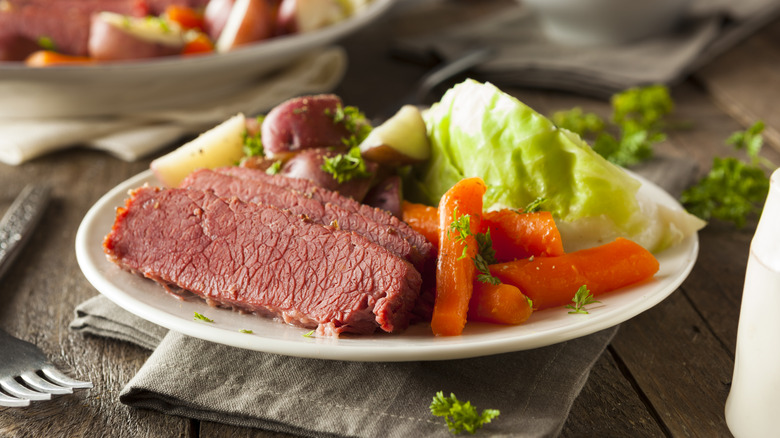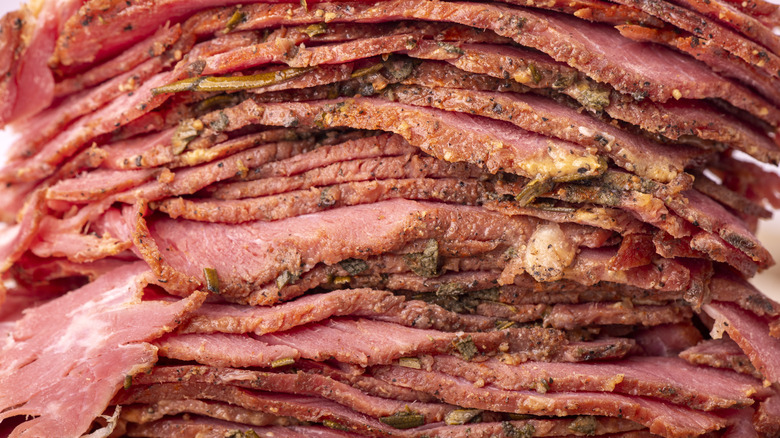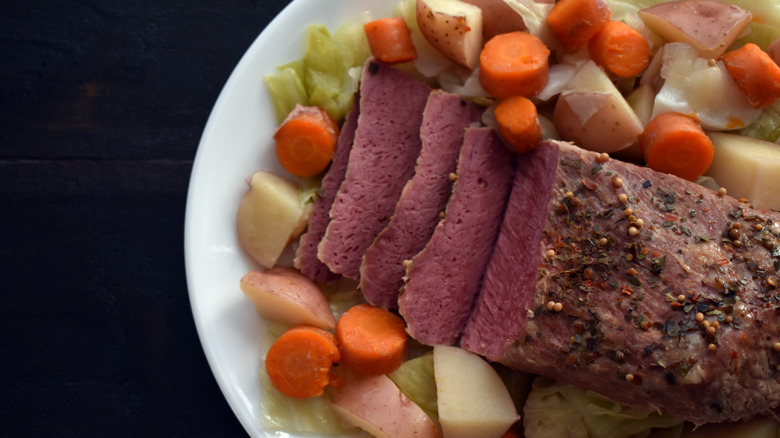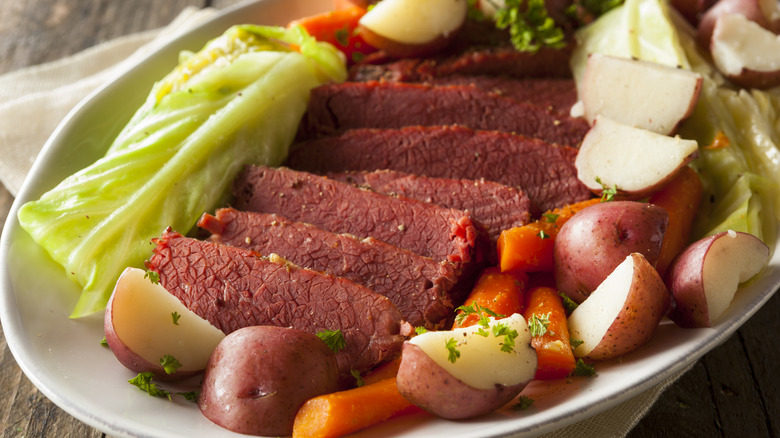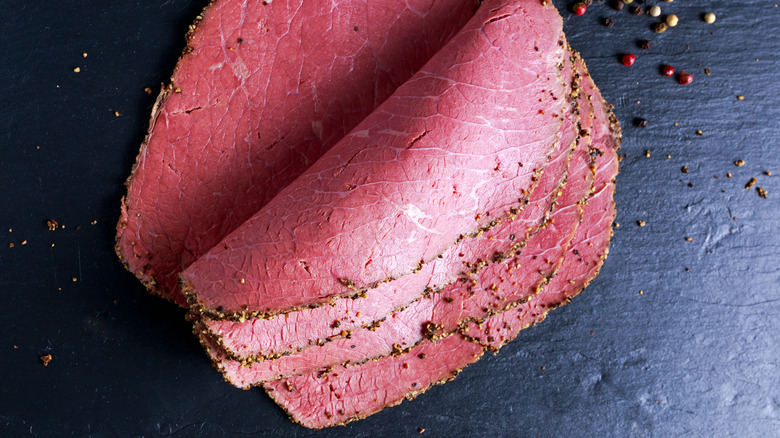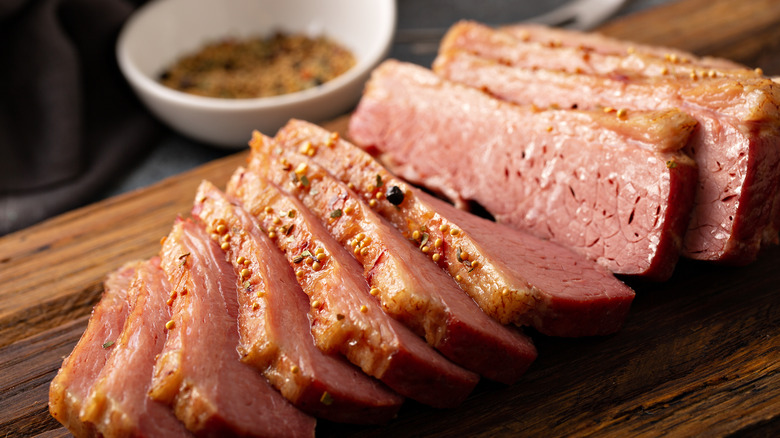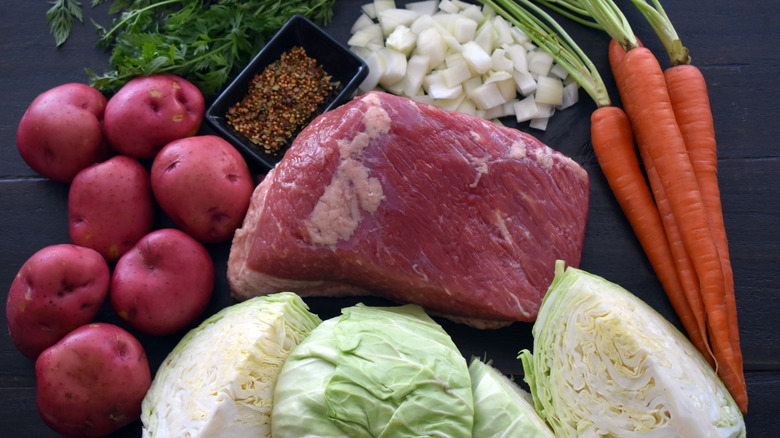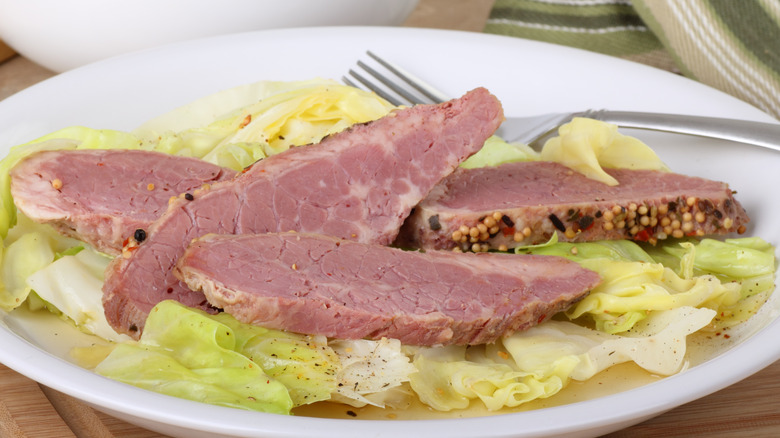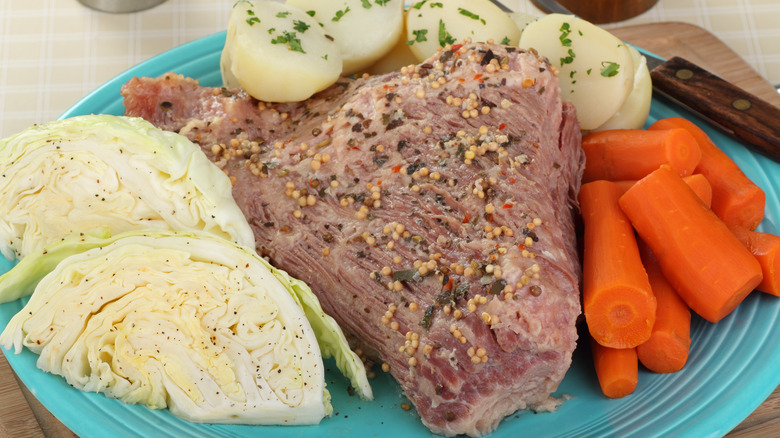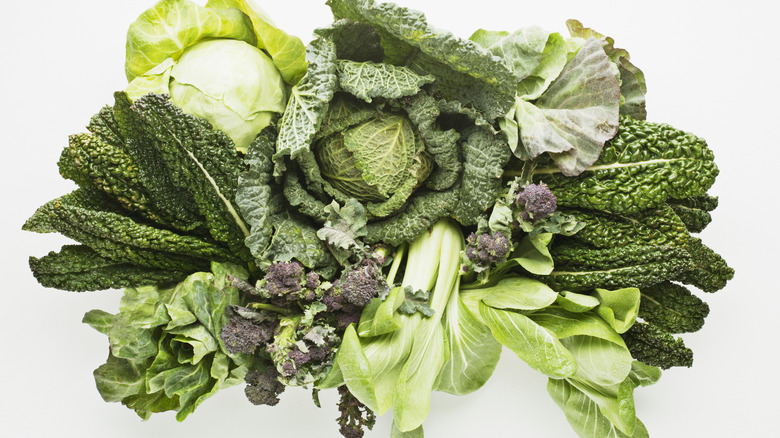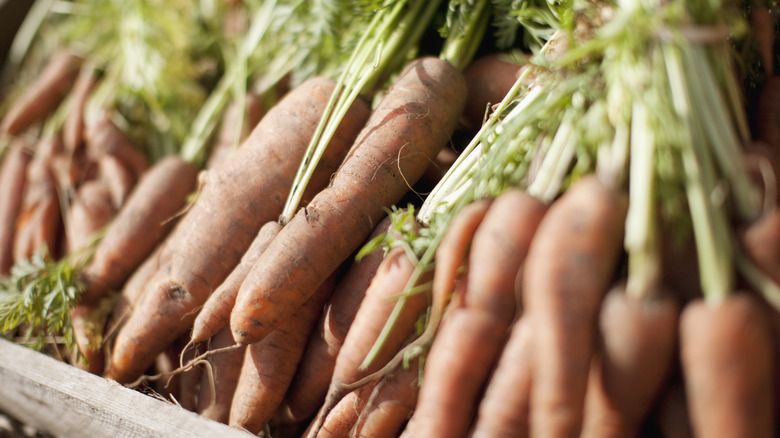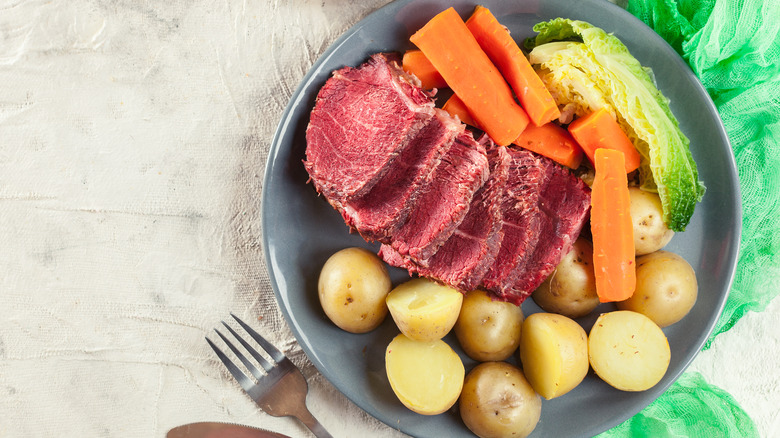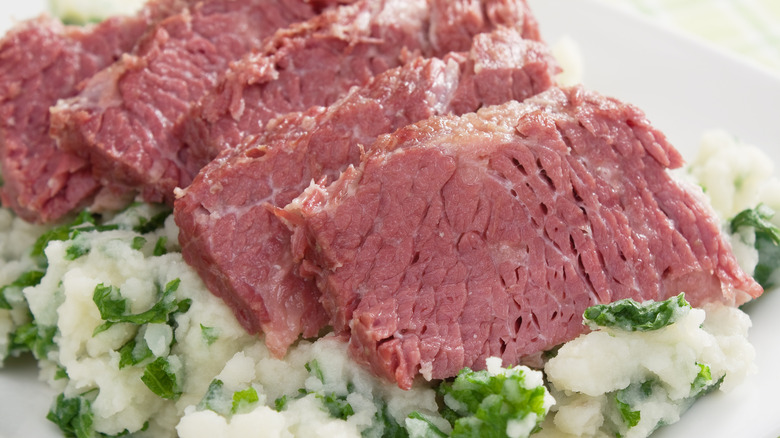Mistakes Everyone Makes When Cooking Corned Beef And Cabbage
As St. Patrick's Day approaches, many cooks turn to the classic celebratory dish of corned beef and cabbage. After all, could anything be more Irish? Well, it turns out that many things can. In reality, corned beef was historically unknown in Ireland. Cattle were prohibitively expensive to raise, so pork was traditionally the meat of choice. Waves of Irish immigrants to the U.S. in the 19th century found the situation reversed — the loin bacon they knew and loved back home was now out of their price range, while mass-produced corned beef (made by curing beef in brine and spices) was fairly affordable.
Thus, frugality inspired Irish Americans to substitute corned beef for bacon in the popular preparation of bacon with cabbage and potatoes. The fact that the corned beef version could be cooked in a single pot was a plus for large, cash-strapped families living in cramped quarters with little cooking space. Over time, corned beef and cabbage came to be closely associated with the Irish-American community, and to most Americans, with Irish cooking in general.
Even if it's not authentically Irish, it still tells an interesting story about Irish immigration to the U.S. that's worth remembering and retelling — and most importantly, it's delicious if done right. Avoid these critical mistakes if you want to make your Irish-American friends proud this St. Patrick's Day.
Choosing an overly lean cut of corned beef
Health-conscious cooks are conditioned to steer toward lean cuts of meat no matter what. For cuts that are naturally tender, this makes sense; big layers or veins of fat can look downright unappetizing as well as unhealthy, so it's understandable to want to steer clear. But it's worth remembering that not all fat is bad, at least from a culinary perspective.
Corned beef is traditionally made from brisket, a large tough cut of meat that counts on fat to provide flavor and keep the meat moist and tender as it cooks. While most diners don't want big gobs of visible fat in their corned beef, going for the leanest possible option will result in disappointment. "What you want is a well-trimmed corned beef," meat expert Sanford Herskovitz, known as Mister Brisket, tells Cleveland.com. "When you have a really lean corned beef, you might as well eat cardboard."
And as butcher Kris Kreiger tells the outlet, much of the visible fat on uncooked corned beef will render out after cooking, so don't worry too much about unattractive fat streaks in the final product. "In meat, you're paying for that marbling," Krieger says. "A lot of that fat melts away, and it makes it nice and juicy." If you do still have a residual layer of fat on your cooked corned beef, you can simply trim it away before serving.
Buying too small a piece of corned beef
Unless you routinely cook for a large family, the big chunks of prepackaged corned beef in your butcher's refrigerator can look dauntingly big and far more than a typical household of three or four people could possibly eat in one sitting. While leftovers are nice for sandwiches and hash, how much corned beef can your family possibly eat before growing thoroughly sick of the stuff?
It would be a big mistake to believe all those big hunks of corned beef are intended to feed a crowd. Much of what you find on the market today has been pumped with brine as part of the curing process. Since a fair deal of the brine drains out as the corned beef cooks, your meat will probably shrink significantly after cooking — typically by 25 to 40 percent. So when you're shopping for corned beef, remember the piece you buy will likely shrink by about a third, so buy accordingly — you'll probably need more than you think.
Buying the cheapest corned beef you can find
Even though corned beef became popular among Irish immigrants because it was so inexpensive, this is unfortunately no longer the case. For most of us, corned beef and cabbage is a celebration meal rather than a standby, so to ensure the occasion is memorable in a good way, it's well worth your while to invest a little more in a good piece of meat. Cheap brands of corned beef are inexpensive for a reason — some are cured with little consideration for flavor and may be overly salty or otherwise unremarkable tasting. If you really want to get a flavorful product to enjoy, take the time to do some research on popular brands or ask your friends or butcher what kind of corned beef they'd recommend.
An even better choice is to seek out a local butcher who makes corned beef on-site — they will likely have put some serious thought into the choice of spices and curing method used. Or if you're willing to plan ahead and want to guarantee your corned beef tastes exactly the way you want it, make your own by curing a brisket in a spiced brine for 10 days in the refrigerator. It's not technically difficult to do and will earn you serious bragging rights among your friends.
Not rinsing off your corned beef before cooking
When corned beef and cabbage are each prepared with care, the whole is greater than the sum of its parts. At the heart of the dish, of course, is the corned beef. The vegetables — cabbage, potatoes, carrots, and other root veggies such as turnips or rutabagas — provide a sweet foil to the salty meat. Tying everything together is the broth in which everything is cooked, which should ideally be a balanced marriage of flavors.
What you don't want when you sip the braising liquid, however, is a mouthful of salt. Corned beef is loaded with salt (since it's soaked in brine as part of its curing process), and while all this salt is required for curing, you don't need all of it in your final dish. Thus, before cooking your corned beef, it's a good practice to rinse it thoroughly. Don't be afraid that this step will result in bland-tasting meat or braising liquid — it won't. There will be more than enough salt in the corned beef after rinsing to ensure flavorful broth and veggies.
Not using enough water for simmering
When making corned beef and cabbage, your aim to is to keep the meat moist as it cooks — this will help ensure it stays juicy when done. This is why the traditional cooking method of simmering the corned beef and cabbage in a pot of water on the stove has worked so well for generations of cooks: It's a low-maintenance cooking method that just requires you to check it from time to time to ensure the water hasn't evaporated, and it uses equipment almost everyone has.
But if you're used to prepping other cuts of meat by pan-searing or roasting them, the idea of submerging a large, expensive cut of beef in a pot of water to cook may seem counterintuitive. Trust tradition — it works. You won't get the crusty, caramelized exterior of a roast or steak, but if you're patient, you'll get fork-tender flavorful meat, provided you keep the corned beef fully submerged. The same rule holds if you're cooking your corned beef in an Instant Pot or slow cooker.
Not seasoning your cooking liquid
If you open a vacuum-sealed piece of corned beef and find a small packet of peppercorns and other spices, it's not there by accident. Hang onto it, because it can take your corned beef and cabbage from good to great. The packet contains an extra dose of the pickling spices used to cure the corned beef and it's there to add extra flavor to your meat as it cooks. Simply dump the spices into your cooking pot or slow cooker when you add the corned beef and water, and the spices will flavor the cooking liquid and everything you cook in it.
If your corned beef doesn't come with its own packet of spices, don't worry. You can (and should) make your own spice blend. Recipes vary, but typically contain spices including cinnamon sticks, black peppercorns, coriander seeds, allspice berries, dill, fennel, and mustard seeds, as well as cloves, ginger, and bay leaves. Some cooks also add extra flavor to their cooking liquid by pouring in a bit of beer, such as Guinness.
Cooking your corned beef too long or not enough
For a proper plate of corned beef and cabbage, timing is everything. Brisket is a large, tough cut of meat with a lot of fat and connective tissue, so it requires a long, slow, and careful cooking process to ensure the muscle and connective tissues relax and become tender, while the fat fully renders out to moisturize the meat. This means that even though corned beef and cabbage is pretty simple to prepare, the dish is not a last-minute project — you're not going to be able to rush home from work at 5:30 p.m., put it on to cook, and expect to have an early dinner. Stovetop corned beef and cabbage will take at least a couple of hours, while making the dish in the slow cooker will require six or more hours.
It's also possible, however, to overcook corned beef — if you do, it will crumble instead of slicing when cut. This isn't a fatal flaw though as the crumbly bits will still be good in a corned beef hash. To prevent overcooking, check your corned beef after a couple of hours — you'll know it's ready when it is tender enough to pierce easily with a fork.
Cooking your corned beef over high heat
There's no getting around it: Corned beef and cabbage takes a long time to cook. And while the process is largely hands-off, it's common for impatient cooks to try to rush it by cooking their corned beef at a high temperature. While this may produce fully cooked corned beef in less time, you'll end up with a dry, tough, and disappointing chunk of meat.
The reason for this outcome is due to the inherent toughness of the brisket cut. While the resilient muscle tissues in brisket will cook through as quickly as any other cut of meat, only time and patience can tenderize them. Thus, low heat and a long cooking time are essential for ensuring your corned beef has the optimal consistency, while simultaneously giving the internal fat enough time to fully melt and permeate the meat by the time it's cooked. For best results, the cooking liquid for your corned beef and cabbage should never boil but stay at a steady simmer instead.
Be sure to schedule ample time to ensure your corned beef and cabbage dish is perfectly cooked — and if it looks like your calendar will be packed on St. Patrick's Day, consider making the meal ahead of time.
Not paying attention to your vegetables
It goes without saying that corned beef is the starring cast member of a corned beef and cabbage dish. This means that all too often, the vegetables are treated as an afterthought. They shouldn't be — besides adding much welcome color and flavor, they are responsible for transforming the dish from a plain hunk of boiled meat into a meal worthy of celebration. They might only be supporting cast members, but they're important ones and should be chosen and treated with care.
For a flavorful and visually appealing dish, don't limit your vegetables to just cabbage. Carrots and potatoes are also traditional, but other good additions that complement the flavor of corned beef are turnips and rutabagas. Cut your veggies into big chunks of roughly equal sizes — uniform shapes and sizes not only look better, but they'll also help your veggies cook at a similar rate.
Don't stint on the cabbage — it becomes sweet and flavorful braised in the corned beef broth, and you and your guests may end up eating more than you expected. Cut your cabbage in half lengthwise through the stem, then cut each half into equal-sized wedges leaving the stem to ensure the wedges stay intact during cooking.
Overcooking your vegetables
Corned beef and cabbage has a reputation as a set-it-and-forget-it kind of dish — just dump everything into a pot, turn on the heat, and wait. But just as the cooking time for the corned beef requires thought and attention, so does the cooking time for the vegetables. It's common, for instance, for cooks to throw all the vegetables into the pot at the same time, whether at the beginning of the long cook (which will result in at least some of them turning out mushy, if not dissolving entirely) or near the end (which may result in some being undercooked or unevenly cooked through).
In short, while your corned beef may take several hours to cook, your vegetables won't. Be sure to give your corned beef a long head start before adding the vegetables. Cut-up root vegetables only take about 15 minutes to cook, so they should be added close to the end of the cooking time. Cabbage takes even less time to cook — around five minutes — so it should be added in last. Meanwhile, some cooks prefer to cook their vegetables in batches in the cooking broth after the cooked corned beef has been removed from the pot and set aside to rest. This allows more control over each ingredient, ensuring everything is cooked to perfection.
Slicing your corned beef incorrectly
Corned beef and cabbage is a dish designed for a crowd, and if you want to ensure everyone can dig in once it hits the table, you first need to cut the cooked beef into serving-sized slices. Ideally, slices should be even and hold together nicely when cut, without being tough or stringy looking. This is not hard to do — but it's easy for hurried cooks, tired after hours of cooking and faced with a crowd of hungry dinner guests, to rush the slicing without paying attention and end up with messy frayed pieces.
This doesn't have to be you. For even and neat slices, start with the right equipment. You'll need a cutting board big enough to hold the corned beef and a long sharp carving knife. If there's a visible fat cap left on the meat, you might want to remove it. Next, look closely at the corned beef to determine the direction of the grain. You want to make your slices against the grain to ensure an attractive appearance and appealing mouthfeel.
Trying to slice your corned beef while it's still hot
As you've probably figured out by now, corned beef and cabbage is an inherently simple dish, but that doesn't always mean it's easy to make. Seemingly tiny details in timing and cooking temperature can make the difference between a meh and marvelous meal. And while it doesn't require a whole lot of hands-on work from the cook, corned beef and cabbage requires patience and attention — and this doesn't end when you turn off the stove.
Of course, it's normal to want to serve up your creation as quickly as possible. After all, you've been smelling it as it cooks all afternoon and you're probably starving. But one final step at the end of the process can make a huge difference in how attractive your corned beef looks when you bring it to the table: waiting for it to rest before slicing it. Resting meat after cooking allows it to reabsorb its juices, ensuring they remain in the slices rather than leaking onto your cutting board. This will not only give you better-looking slices but they'll be far better tasting too.
